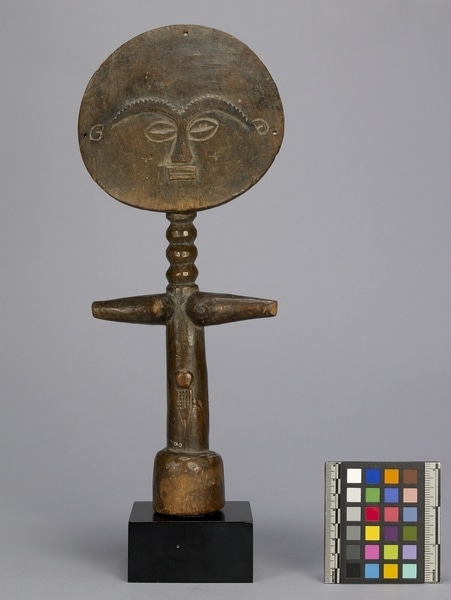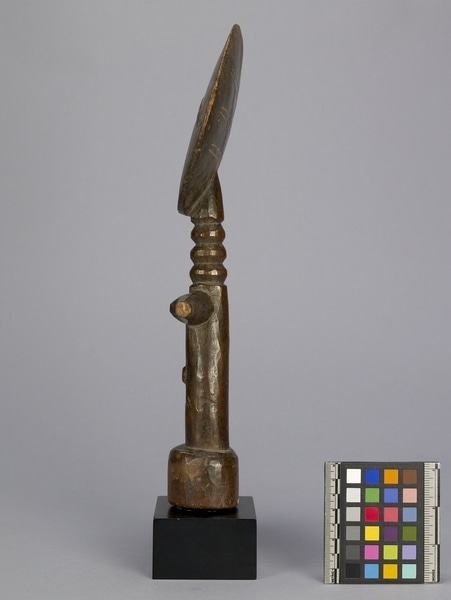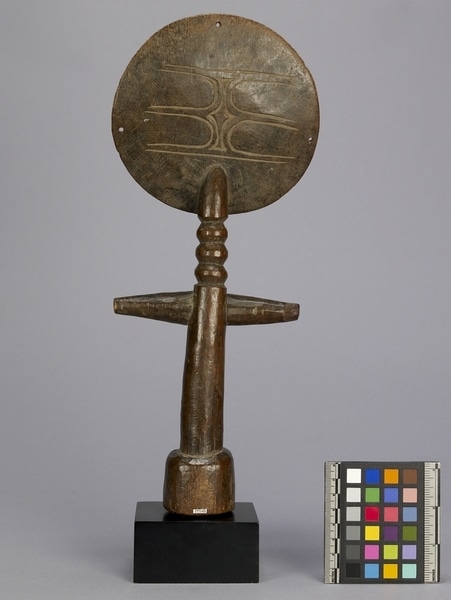Fertility Figure Item Number: 771/49 from the MOA: University of British Columbia




Description
Fertility figure (akuaba) with a flat, disc-shaped head. Carved from brown wood, with a simple cross-shaped design for the body. A round, raised knob with a rectilinear carved design extending below it marks the area around the figure's stomach. Neck is carved into three spherical shapes stacked one on top of the other. Face is large, round and flat with shallowly carved, reductive facial features and three small round holes bored through the wood at the outer extremities near the ears and the height of the forehead. Three parallel horizontal double lines connected vertically through the centre are carved on the reverse of the face. The entire figure is mounted on a black rectangular wooden base.
History Of Use
Akuaba fertility figures were carved for young Asante women in order to promote fertility and to ensure the beauty of a child. Women would have them carved by an adwinfo (carver), who were usually recommended to them by a priest. The figures were then carried close to the body, often wrapped in cloth around the waist or back, and treated like a real child. A woman would carry the figure until she became visibly pregnant or until she gave birth. After the birth of the child, Akuaba figures would often be used in shrines or as an offering to the gods. They were also sometimes used as memorials to children and became family heirlooms that were taken care of and passed down through generations. The origins of this practice are from the story of Akua, an Akan woman who was infertile but strongly desired children. She was instructed by a priest to commission a carving of a child which she would carry and treat as if it were real. Despite being ridiculed, Akua followed the instructions and was able to conceive a child. The practice was soon adopted throughout the region. Akuaba are now commonly sold in markets and used for decoration.
Iconographic Meaning
The shape of the Akuaba figure represents the idealized standard of beauty for the Akan. The varying sizes of the different parts of the body are a reflection of an Akan carver’s idea of "proportions of significance". The head in most cases is large and the most dominate feature of the figure as it is considered the seat of wisdom, life, and survival. Akuaba figures would also be decorated with beads to ensure that child would be beautiful and as a way to show wealth, and how well cared for the child would be. All traditional Akuaba figures are female images, primarily because Akua's first child was a girl but also because Akan society was matrilineal.
Item History
- Made in Ghana
- Owned by Walter C. Koerner before January 18, 1982
- Received from Walter C. Koerner (Donor) on January 18, 1982
What
Who
- Culture
- Asante
- Previous Owner
- Walter C. Koerner
- Received from
- Walter C. Koerner (Donor)
Where
- Holding Institution
- MOA: University of British Columbia
- Made in
- Ghana
When
- Ownership Date
- before January 18, 1982
- Acquisition Date
- on January 18, 1982
Other
- Item Classes
- carvings & sculpture
- Condition
- good
- Current Location
- Case 98
- Accession Number
- 0771/0049